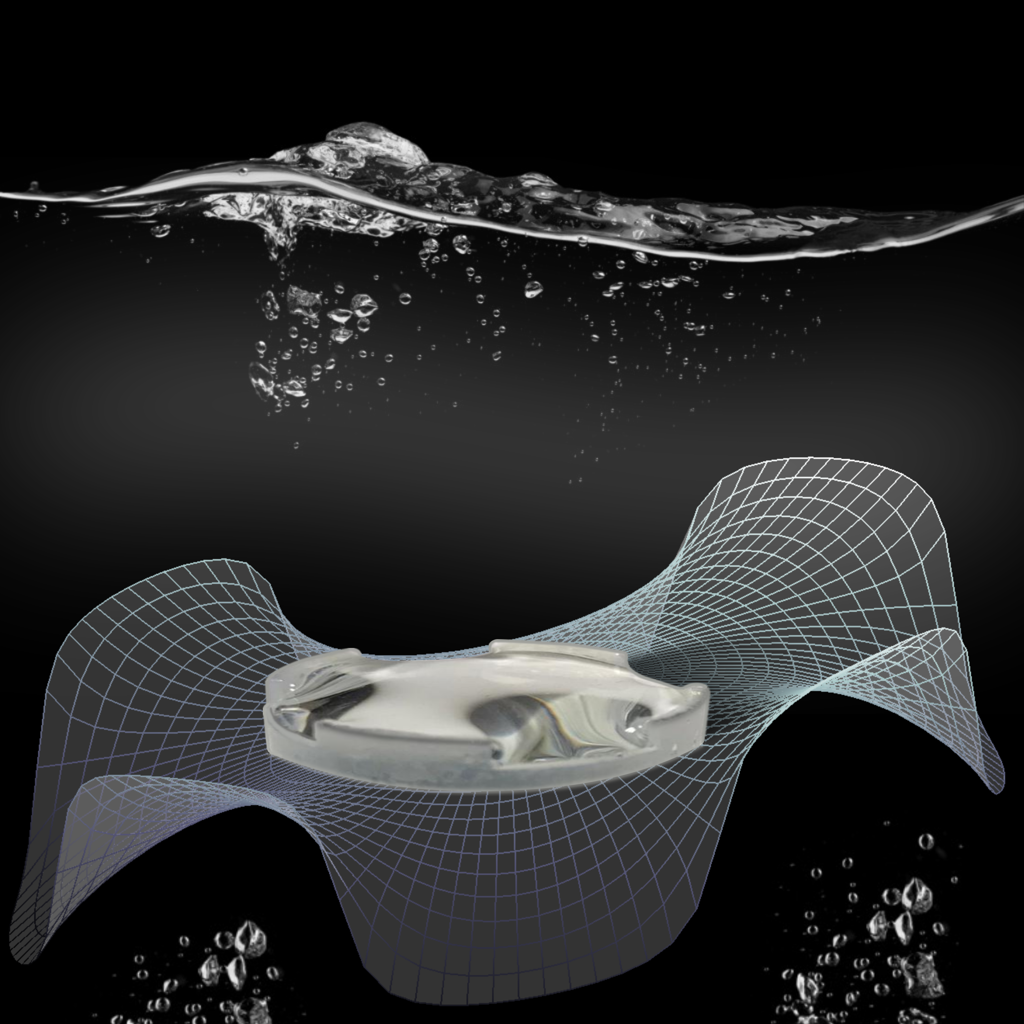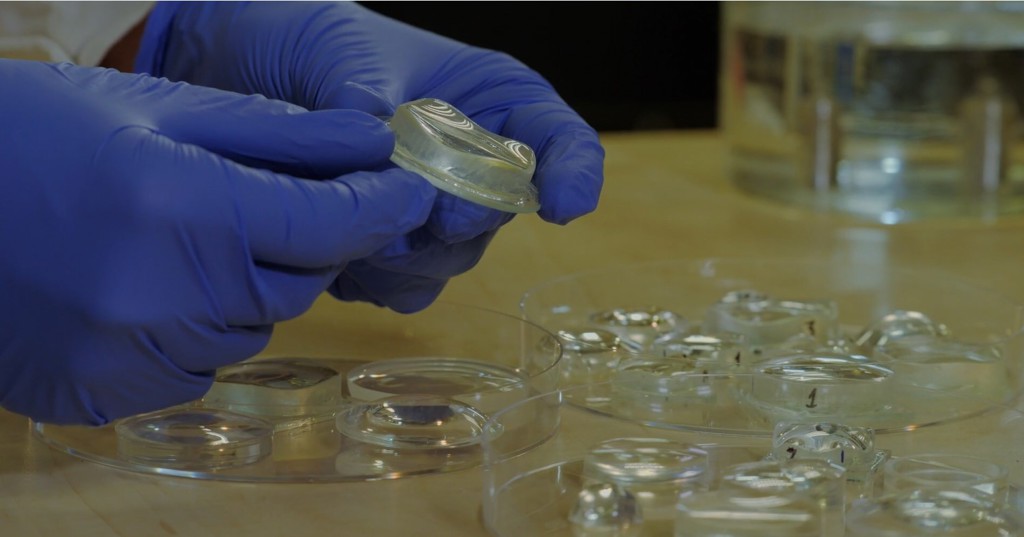Researchers Fabricate Complex Optical Components from Fluids
About Optica
18 November 2021
Researchers Fabricate Complex Optical Components from Fluids
Inexpensive, fast method to make freeform optics could benefit applications from eyewear to telescopes
WASHINGTON — Researchers have developed a way to create freeform optical components by shaping a volume of curable liquid polymer. The new method is poised to enable faster prototyping of customized optical components for a variety of applications including corrective lenses, augmented and virtual reality, autonomous vehicles, medical imaging and astronomy.
Common devices such as eyeglasses or cameras rely on lenses – optical components with spherical or cylindrical surfaces, or slight deviations from such shapes. However, more advanced optical functionalities can be obtained from surfaces with complex topographies. Currently, fabricating such freeform optics is very difficult and expensive because of the specialized equipment required to mechanically process and polish their surfaces.

Caption: Freeform optical components with sub-nanometer surface roughness are fabricated within minutes by shaping liquid volume
Credit: Technion – Israel Institute of Technology
“Our approach to making freeform optics achieves extremely smooth surfaces and can be implemented using basic equipment that can be found in most labs,” said research team leader Moran Bercovici from the Technion – Israel Institute of Technology. “This makes the technology very accessible, even in low resource settings.”
In Optica, Optica Publishing Group’s journal for high-impact research, Bercovici and colleagues show that their new technique can be used to fabricate freeform components with sub-nanometer surface roughness in just minutes. Unlike other prototyping methods such as 3D printing, the fabrication time remains short even if the volume of the manufactured component increases.
“Currently, optical engineers pay tens of thousands of dollars for specially designed freeform components and wait months for them to arrive,” said Omer Luria, one of the contributors to the paper. “Our technology is poised to radically decrease both the waiting time and the cost of complex optical prototypes, which could greatly speed up the development of new optical designs.”
From eyeglasses to complex optics
The researchers decided to develop the new method after learning that 2.5 billion people around the world don’t have access to corrective eyewear. “We set out to find a simple method for fabricating high quality optical components that does not rely on mechanical processing or complex and expensive infrastructure,” said Valeri Frumkin, who first developed the method in Bercovici’s lab. “We then discovered that we could expand our method to produce much more complex and interesting optical topographies.”
One of the primary challenges in making optics by curing a liquid polymer is that for optics larger than about 2 millimeters, gravity dominates over surface forces, which causes the liquid to flatten into a puddle. To overcome this, the researchers developed a way to fabricate lenses using liquid polymer that is submerged in another liquid. The buoyancy counteracts gravity, allowing surface tension to dominate.

Caption: The researchers used their new method to make optical components with various geometries — including toroid and trefoil shapes — and sizes up to 200 mm as well as freeform surfaces. The lenses exhibited surface qualities similar to the best polishing technologies available while being orders of magnitude quicker and simpler to make.
Credit: Technion – Israel Institute of Technology
With gravity out of the picture, the researchers could fabricate smooth optical surfaces by controlling the surface topography of the lens liquid. This entails injecting the lens liquid into a supportive frame so that the lens liquid wets the inside of the frame and then relaxes into a stable configuration. Once the required topography is achieved, the lens liquid can be solidified by UV exposure or other methods to complete the fabrication process.
After using the liquid fabrication method to make simple spherical lenses, the researchers expanded to optical components with various geometries — including toroid and trefoil shapes — and sizes up to 200 mm. They show that the resulting lenses exhibited surface qualities similar to the best polishing technologies available while being orders of magnitude quicker and simpler to make. In the work published in Optica, they further expanded the method to create freeform surfaces, by modifying the shape of the supportive frame.
Infinite possibilities
“We identified an infinite range of possible optical topographies that can be fabricated using our approach,” said Mor Elgarisi, the paper’s lead author. “The method can be used to make components of any size, and because liquid surfaces are naturally smooth, no polishing is required. The approach is also compatible with any liquid that can be solidified and has the advantage of not producing any waste.”
The researchers are now working to automate the fabrication process so that various optical topographies can be made in a precise and repeatable way. They are also experimenting with various optical polymers to find out which ones produce the best optical components.
Paper: M. Elgarisi, V. Frumkin, O. Luria, M. Bercovici, “Fabrication of freeform optical components by fluidic shaping,” Optica, 8, 11, 1501-1506 (2021).
DOI: 10.1364/OPTICA.438763.
About Optica Publishing Group
Optica Publishing Group is a division of the society, Optica, Advancing Optics and Photonics Worldwide. It publishes the largest collection of peer-reviewed and most-cited content in optics and photonics, including 18 prestigious journals, the society’s flagship member magazine, and papers and videos from more than 835 conferences. With over 400,000 journal articles, conference papers and videos to search, discover and access, our publications portfolio represents the full range of research in the field from around the globe.
About Optica
Optica is an open-access journal dedicated to the rapid dissemination of high-impact peer-reviewed research across the entire spectrum of optics and photonics. Published monthly by Optica Publishing Group, the Journal provides a forum for pioneering research to be swiftly accessed by the international community, whether that research is theoretical or experimental, fundamental or applied. Optica maintains a distinguished editorial board of more than 60 associate editors from around the world and is overseen by Editor-in-Chief Prem Kumar, Northwestern University, USA. For more information, visit Optica.
Media Contact
